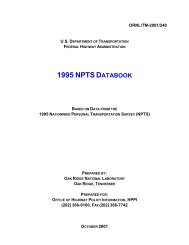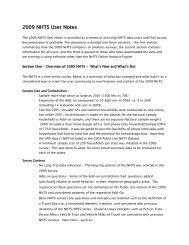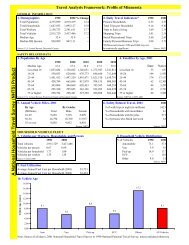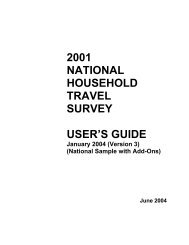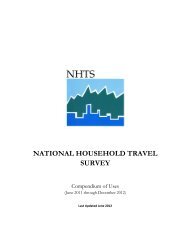Uses of National Household Travel Survey Data in - NHTS Home ...
Uses of National Household Travel Survey Data in - NHTS Home ...
Uses of National Household Travel Survey Data in - NHTS Home ...
Create successful ePaper yourself
Turn your PDF publications into a flip-book with our unique Google optimized e-Paper software.
Bike and Pedestrian Studies<br />
Neighborhood Design and Walk<strong>in</strong>g Trips <strong>in</strong> Ten U.S. Metropolitan Areas<br />
Authors:<br />
Boer, Rob; Zheng, Yuhui; Overton, Adrian; Ridgeway, Gregory K; Cohen, Deborah A<br />
American Journal <strong>of</strong> Preventive Medic<strong>in</strong>e Issue: 4<br />
4/1/2007<br />
Abstract:<br />
Despite substantial evidence for neighborhood characteristics correlat<strong>in</strong>g with walk<strong>in</strong>g, there has been to<br />
date only limited attention paid to possible practical implications for neighborhood design. This study<br />
<strong>in</strong>vestigates to what extent design guidel<strong>in</strong>es are likely to stimulate walk<strong>in</strong>g. Four <strong>of</strong> the New Urbanism<br />
Smart Scorecard criteria and 2 other measures were tested for their <strong>in</strong>fluence on walk<strong>in</strong>g. <strong>Data</strong> was<br />
obta<strong>in</strong>ed from the 1995 <strong>National</strong> Personal Transportation <strong>Survey</strong>, U.S. Census 2000, and InfoUSA.<br />
Propensity-score methodology was used to control for potential confounders. Higher levels <strong>of</strong> bus<strong>in</strong>ess<br />
diversity and higher percentages <strong>of</strong> 4-way <strong>in</strong>tersections were associated with more walk<strong>in</strong>g. For example,<br />
the odds ratio (OR) for walk<strong>in</strong>g <strong>in</strong> a neighborhood with 4 bus<strong>in</strong>ess types present compared to 3 bus<strong>in</strong>ess<br />
types was 1.24 (confidence <strong>in</strong>terval [CI] 1.07 & 1.44) and neighborhoods with 50 & 74%, 4-way<br />
<strong>in</strong>tersections had an OR for walk<strong>in</strong>g <strong>of</strong> 1.4 (CI 1.09 & 1.78) relative to those with 25 & 49%, 4-way<br />
<strong>in</strong>tersections. The effects <strong>of</strong> hous<strong>in</strong>g density on walk<strong>in</strong>g are mixed. Higher park<strong>in</strong>g pressure and older<br />
median hous<strong>in</strong>g age did not significantly affect walk<strong>in</strong>g after covariate adjustment. Block length did not<br />
appear to be associated with walk<strong>in</strong>g. When consider<strong>in</strong>g the New Urbanism Smart Scorecard from the<br />
perspective <strong>of</strong> walk<strong>in</strong>g, some, but not all, <strong>of</strong> its criteria that appear to have a correlation with walk<strong>in</strong>g are<br />
likely to be useful for design<strong>in</strong>g walkable communities.<br />
Subject areas and Index Terms<br />
Energy; Environment; Highways; Pedestrians and Bicyclists; Plann<strong>in</strong>g and Forecast<strong>in</strong>g; I15:<br />
Environment; I21: Plann<strong>in</strong>g <strong>of</strong> Transport Infrastructure<br />
Metropolitan areas; Mode choice; Susta<strong>in</strong>able development; Susta<strong>in</strong>able transportation; <strong>Travel</strong> behavior;<br />
<strong>Travel</strong> by mode; Urban design; Walk<strong>in</strong>g<br />
Availability: F<strong>in</strong>d a library where document is available Order URL: http://worldcat.org/issn/07493797<br />
4



